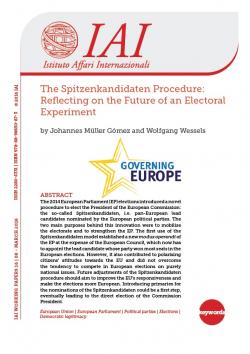The Spitzenkandidaten Procedure: Reflecting on the Future of an Electoral Experiment
The 2014 European Parliament (EP) elections introduced a novel procedure to elect the President of the European Commission: the so-called Spitzenkandidaten, i.e. pan-European lead candidates nominated by the European political parties. The two main purposes behind this innovation were to mobilise the electorate and to strengthen the EP. The first use of the Spitzenkandidaten model established a new modus operandi of the EP at the expense of the European Council, which now has to appoint the lead candidate whose party won most seats in the European elections. However, it also contributed to polarising citizens’ attitudes towards the EU and did not overcome the tendency to compete in European elections on purely national issues. Future adjustments of the Spitzenkandidaten procedure should aim to improve the EU’s responsiveness and make the elections more European. Introducing primaries for the nominations of the Spitzenkandidaten could be a first step, eventually leading to the direct election of the Commission President.
Paper prepared within the context of “Governing Europe”, a joint project led by the Istituto Affari Internazionali (IAI) and Centro Studi sul Federalismo (CSF) of Turin in the framework of the strategic partnership with Compagnia di San Paolo, International Affairs Programme. Publ. in: Lorenzo Vai, Pier Domenico Tortola, Nicoletta Pirozzi (eds.), Governing Europe. How to Make the EU More Efficient and Democratic, Bruxelles [etc], P.I.E-Peter Lang, 2017, 248 p. (Federalism ; 8), ISBN 978-2-8076-0058-4 (pbk); 978-2-8076-0059-1 (pdf); 978-2-8076-0060-7 (EPUB); DOI: 10.3726/b10699.
-
Details
Roma, IAI, March 2016, 25 p. -
Issue
16|08 -
ISBN/ISSN/DOI:
978-88-98650-87-3
Introduction
1. Spitzenkandidaten: A contested model
2. The implications of Spitzenkandidaten: Much ado about nothing?
2.1 Elections without voters: The persistence of the second-order effects
2.2 Until further notice: A victory of the European Parliament
3. Lessons learned: 2014 preparing for 2019?
3.1 Some progress: A few new incentives being set
3.2 A realistic view: Limitations of further developments
4. Recommendations: (How) can the Spitzenkandidaten concept be improved?
4.1 Transnational lists: Towards EU parliamentarism
4.2 Direct election of the Commission President: Towards a responsive presidentialism
4.3 European primaries: Learning from the US, raising more awareness
Conclusion: Comprehensively satisfying solutions remain to be invented
References
Topic
Tag
Related content
-
Ricerca27/01/2015
Governing Europe
leggi tutto



